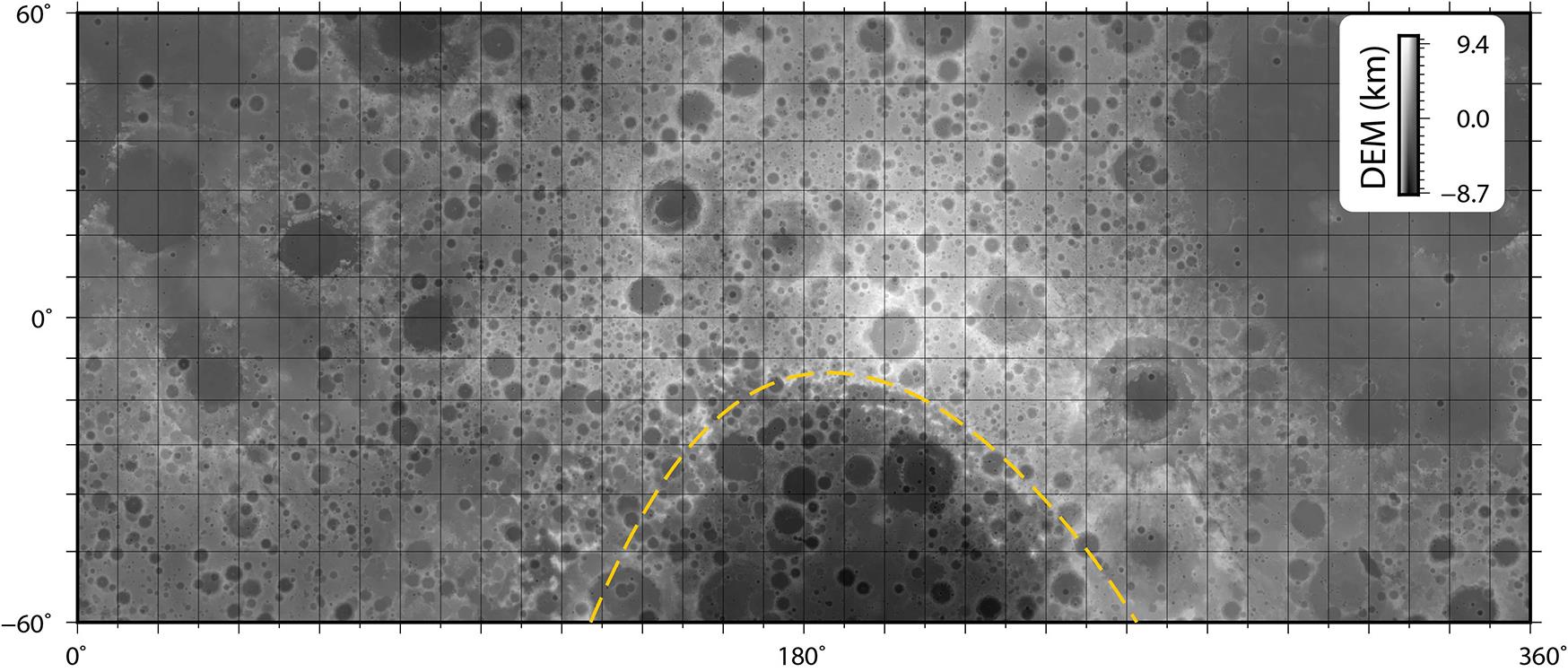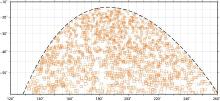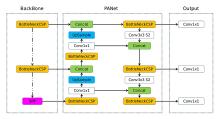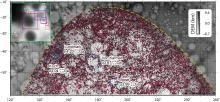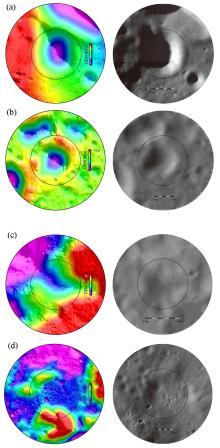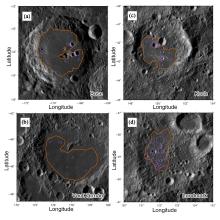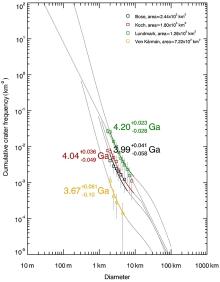南京大学学报(自然科学版) ›› 2021, Vol. 57 ›› Issue (6): 905–915.doi: 10.13232/j.cnki.jnju.2021.06.001
• • 下一篇
基于卷积神经网络的月球南极⁃艾特肯盆地撞击坑自动识别及中型撞击坑绝对模式年龄估算
- 1.月球与行星科学国家重点实验室,澳门科技大学,澳门,999078
2.国家航天局澳门太空探索与科学中心,澳门,999078
3.数据科学与信息技术研究中心, 清华?伯克利深圳学院,深圳,518000
Automated crater detection on the South Pole⁃Aitken basin of the Moon and absolute model ages of mid⁃sized craters based on convolution neural network
Xingli Cui1,2, Min Ding1,2( ), Guan Wang3
), Guan Wang3
- 1.State Key Laboratory of Lunar and Planetary Sciences, Macau University of Science and Technology, Macau, 999078, China
2.CNSA Macau Center for Space Exploration and Science, Macau, 999078, China
3.Data Science and Information Technology Research Center, Tsinghua?Berkeley Shenzhen institute, Shenzhen, 518000, China
摘要:
月球南极?艾特肯盆地是太阳系最大的撞击盆地之一,也是月球上最大、最古老的撞击盆地.南极?艾特肯盆地是研究早期大型撞击事件的重要窗口,而小型撞击坑的识别与计数定年是研究南极?艾特肯盆地演化史的基础.由于撞击坑直径和数量符合幂次定律,数量众多的小型撞击坑难以单纯依靠人力进行识别.近年来,计算机算力的提升使得训练复杂的卷积神经网络成为可能.采用已有的专家标注训练神经网络,进而实现图像特征的自动提取,能够在保证准确率的同时极大地提高识别效率.采用基于卷积神经网络算法的You Only Look Once Version5 (YOLO V5)目标探测系统来自动识别月球南极?艾特肯盆地直径为2~15 km的小型撞击坑.在训练神经网络时,使用融合了SELENE和LRO数据的数字高程模型SLDEM2015和最新的专家标记撞击坑数据库.训练好的网络在测试集上的结果与专家标记的撞击坑数据库相比,识别结果的准确率(Precision)为0.96,召回率(Recall)为0.95,F1值为0.95.通过对与专家标注不符的识别结果进行可视化,识别出至少十个专家误标记的撞击坑,证明撞击坑自动识别方法可以用于检验专家标注的可靠性.基于南极?艾特肯盆地的撞击坑自动识别结果,确定了南极?艾特肯盆地四个典型中型撞击坑的绝对模式年龄,并与已有的定年结果对比,进一步验证了自动识别结果的可靠性,也显示了提出的方法在利用自动识别的撞击坑进行中型撞击坑定年方面的潜力.提出的撞击坑自动识别方法有望进一步拓展到更小撞击坑的识别,并迁移到月球其他地质单元乃至其他行星的研究中.
中图分类号:
- P691
| 1 | Head J W,Fassett C I,Kadish S J,et al. Global distribution of large lunar craters:Implications for resurfacing and impactor populations. Science,2010,329(5998):1504-1507. |
| 2 | Povilaitis R Z,Robinson M S,Van der Bogert C H,et al. Crater density differences:Exploring regional resurfacing,secondary crater populations,and crater saturation equilibrium on the moon. Planetary and Space Science,2018,162:41-51. |
| 3 | Robbins S J. A new global database of lunar impact craters>1~2 km:1. Crater locations and sizes,comparisons with published databases,and global analysis. Journal of Geophysical Research:Planets,2019,124(4):871-892. |
| 4 | Robbins S J,Antonenko I,Kirchoff M R,et al. The variability of crater identification among expert and community crater analysts. Icarus,2014,234:109-131. |
| 5 | Emami E,Ahmad T,Bebis G,et al. Lunar crater detection via region?based convolutional neural networks∥The 49th Lunar and Planetary Science Conference. Woodlands,TX,USA:LPI Contribution,2018,2083:2381. |
| 6 | Silburt A,Ali?Dib M,Zhu C,et al. Lunar crater identification via deep learning. Icarus,2019,317:27-38. |
| 7 | Yang C,Zhao H,Bruzzone L,et al. Lunar impact crater identification and age estimation with Chang'E data by deep and transfer learning. Nature Communications,2020,11(1):1-15. |
| 8 | Benedix G K,Lagain A,Chai K,et al. Deriving surface ages on Mars using automated crater counting. Earth and Space Science,2020,7(3):e2019EA001005. |
| 9 | Neukum G,Ivanov B A. Crater size distributions and impact probabilities on Earth from lunar,terrestrial?planet,and asteroid cratering data. Hazards due to Comets and Asteroids,1994,359(1):359-416. |
| 10 | Fassett C I,Head J W,Kadish S J,et al. Lunar impact basins:Stratigraphy,sequence and ages from superposed impact crater populations measured from Lunar Orbiter Laser Altimeter data. Journal of Geophysical Research:Planets,2012,DOI:10.1029/2011JE003951. |
| 11 | Orgel C,Michael G,Fassett C I,et al. Ancient bombardment of the inner solar system:Reinvestigation of the "fingerprints" of different impactor populations on the lunar surface. Journal of Geophysical Research:Planets,2018,123(3):748-762. |
| 12 | Losiak A,Wilhelms D E,Byrne C J,et al. A new lunar impact crater database∥The 40th Lunar and Planetary Science Conference. Woodlands,TX,USA:LPI Contribution,2009:1532. |
| 13 | Ding M,Soderblom J M,Bierson C J,et al. Constraints on lunar crustal porosity from the gravitational signature of impact craters. Journal of Geophysical Research:Planets,2018,123(9):2281-2294. |
| 14 | Ding M,Soderblom J M,Bierson C J,et al. Investigating the Influences of Crustal Thickness and Temperature on the Uplift of Mantle Materials Beneath Large Impact Craters on the Moon. Journal of Geophysical Research:Planets,2021,126(2):e2020JE006533. |
| 15 | Barker M K,Mazarico E,Neumann G A,et al. A new lunar digital elevation model from the Lunar Orbiter Laser Altimeter and SELENE Terrain Camera. Icarus,2016,273:346-355. |
| 16 | Haruyama J,Hara S,Hioki K,et al. Lunar global digital terrain model dataset produced from SELENE (Kaguya) terrain camera stereo observations∥Lunar and Planetary Science Conference. Woodlands,TX,USA:LPI Contribution,2012,1659:1200. |
| 17 | Semechko Anton. Suite of functions to perform uniform sampling of a sphere (https://github.com/AntonSemechko/S2-Sampling-Toolbox),GitHub,Retrieved July 22,2021. |
| 18 | Redmon J,Divvala S,Girshick R,et al. You only look once:Unified,real?time object detection∥Computer Vision and Signal Processing 2016. Las Vegas,NV,USA:IEEE Press,2016:779-788. |
| 19 | Jocher G,Stoken A,Borovec J,et al. Ultralytics/yolov5:V4. 0?Nn. silu () Activations Weights & Biases Logging Pytorch Hub Integration. Zenodo,2021,DOI:10.5281/zenodo.4418161. |
| 20 | Salamuni?car G,Lon?ari? S. Open framework for objective evaluation of crater detection algorithms with first test?field subsystem based on MOLA data. Advances in Space Research,2008,42(1):6-19. |
| 21 | Kneissl T,van Gasselt S,Neukum G. Map?projection?independent crater size?frequency determination in GIS environments?New software tool for ArcGIS. Planetary and Space Science,2011,59(11-12):1243-1254. |
| 22 | Neukum G,Ivanov B A,Hartmann W K. Cratering records in the inner solar system in relation to the lunar reference system. Chronology and Evolution of Mars,2001:55-86. |
| 23 | Michael G G,Neukum G. Planetary surface dating from crater size–frequency distribution measurements:Partial resurfacing events and statistical age uncertainty. Earth and Planetary Science Letters,2010,294(3-4):223-229. |
| 24 | Kirchoff M R,Chapman C R,Marchi S,et al. Ages of large lunar impact craters and implications for bombardment during the Moon's middle age. Icarus,2013,225(1):325-341. |
| 25 | Neukum G,Horn P. Effects of lava flows on lunar crater populations. The Moon,1976,15(3-4):205-222. |
| 26 | Nelson D M,Koeber S D,Daud K,et al. Mapping lunar maria extents and lobate scarps using LROC image products∥The 45th Lunar and planetary science conference. Woodlands,TX,USA:LPI Contribution,2014,1777:2861. |
| 27 | Hiesinger H,van der Bogert C H,Thiessen F,et al. Absolute model ages of light plains in the southern lunar hemisphere∥The 44th Lunar and Planetary Science Conference. Woodlands,TX,USA:LPI Contribution,2013,1719:2827. |
| 28 | Huang J,Xiao Z,Flahaut J,et al. Geological characteristics of Von Kármán crater,northwestern south pole‐Aitken Basin:Chang'E‐4 landing site region. Journal of Geophysical Research:Planets,2018,123(7):1684-1700. |
| 29 | Wilhelms D E,John F,Trask N J. The geologic history of the Moon. Geological Survey Professional Paper 1348. Washington,DC,USA:Government Printing Office,1987. |
| 30 | Neukum G,K?nig B,Arkani?Hamed J. A study of lunar impact crater size?distributions. The Moon,1975,12(2):201-229. |
| 31 | Neukum G,Ivanov B A,Hartmann W K. Cratering records in the inner solar system in relation to the lunar reference system. Chronology and evolution of Mars. Dordrecht:Springer,2001:55-86,DOI:10.1007/978-94-017-1035-0_3. |
| 32 | Neukum G:Ivanov B,Crater size distributions and impact probabilities on Earth from lunar,terrestrial?planet,and asteroid cratering data. Hazards due to Comets and Asteroids,1994,1:359-416. |
| 33 | Wetzler P G,Honda R,Enke B,et al. Learning to detect small impact craters∥2005 Seventh IEEE Workshops on Applications of Computer Vision (WACV/MOTION'05)?Volume 1. Breckenridge,CO,USA:IEEE,2005,1:178-184. |
| 34 | Wagner R V,Speyerer E J,Robinson M S,et al. New mosaicked data products from the LROC team∥The 46th Lunar and Planetary Science Conference. Woodlands,TX,USA:LPI Contribution,2015,1832:1473. |
| 35 | Adler J E M,Salisbury J W. Circularity of lunar craters. Icarus,1969,10(1):37-52. |
| 36 | Barker M K,Mazarico E,Neumann G A,et al. Improved LOLA elevation maps for south pole landing sites:Error estimates and their impact on illumination conditions. Planetary and Space Science,2021,203:105119. |
| 37 | Jolliff B L,Gillis J J,Haskin L A,et al. Major lunar crustal terranes:Surface expressions and crust‐mantle origins. Journal of Geophysical Research:Planets,2000,105(E2):4197-4216. |
|
||


